Which Galleries Carry the Art Work of Carolyn Anderson?
Carolyn Anderson's distinctive style balances abstraction and realism
Past Rosemary Carstens
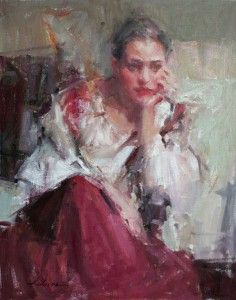
The Ruby-red Skirt, oil, 20 x 16.
"Painting is all nigh seeing. It is truly a wedlock of craft and creativity," says Montana-based artist Carolyn Anderson. "When values, colors, and shapes are put together in interesting ways, when the artist has shown us how to await at something differently, in that location is poesy."
Anderson knows all about the poetry of paint. As a Montana golden prospector might once have swirled earthy aggregate to split gold from sand, Anderson has an infrequent aptitude for reducing superfluous detail to the bare essentials. Her ability to create paintings of bully beauty and energy while showing the states something new nigh her subjects lies at the foundation of her success.
Main painter Quang Ho likewise points out Anderson'due south unique ability to meet and pigment atmosphere, which, he says, "translates into beautifully portrayed, soft, lost and found edges. She is a top-notch draftsman, to be sure, but her apply of pigment and the expression in her works is what sets her apart."
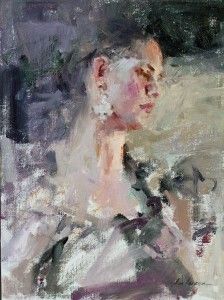
Portrait of a Dancer, oil, xiv x eleven.
Anderson is keenly enlightened of the scientific discipline behind how we meet art—the physiological dance between the center, the brain, and a viewer'southward individual perspective on a painting's meaning or subject matter. She has studied the works of perceptual psychologist and art and film theorist Rudolf Arnheim (Art and Visual Perception: A Psychology of the Creative Eye) and art critic and historian Sir Ernst Gombrich (Art and Illusion: A Study in the Psychology of Pictorial Representation), among others, and continues to be fascinated by ideas about what nosotros see compared to what nosotros think we run into.
When Anderson takes up her brush for a painting such as PORTRAIT OF A DANCER, she strives to interpret and present visual data distilled downwardly to its near essential elements. She uses her experience and craftsmanship to re-create an illusory reality from what she calls "marking making," as she carefully chooses which details to exaggerate and which to sublimate. She asks herself, "How much can I deconstruct this subject matter and however have a recognizable image?" Anderson is enlightened that the eye focuses selectively on simply a small-scale part of any scene, leaving the rest a blur of impressions, and she makes good use of that physiological principle in her work. Shape, light, shadow, and color whirl around a central focal point, in this instance the dancer'southward more sharply delineated face up, to create an aliveness that draws viewers into the feel. She purposely leaves space for viewers to access her works through the lens of personal memory and noesis.
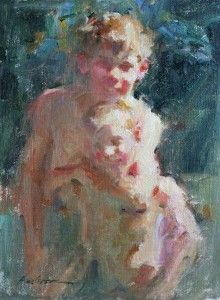
Carolyn Anderson | Brothers, oil, 12 ten 9.
"Carolyn's ability to capture the essence of her subject affair while allowing the viewer to participate is sublime," confirms Meredith Plesko, co-possessor of InSight Gallery in Fredericksburg, TX. "Whether Carolyn is painting a bird, ponies, a cute woman, or a woodsman, her approach is her own merely is ever rooted in representational art. She communicates the beauty of life's unproblematic things and captures those often overlooked moments in life."
Born and raised in the Chicago area, Anderson dreamed of attending the Fine art Institute of Chicago but, instead, pursued a teaching degree at Illinois Land University to satisfy her parents' insistence on a more "applied" path to earning a living. In the early 1970s, she joined Volunteers in Service to America (VISTA), founded in 1965 to fight poverty in the United states, and was sent to the Rocky Boy Indian Reservation in Montana—a far different mural than that of crowded, urban Chicago. Some 25 years after her VISTA service, she returned to Montana and now lives and works in a home she designed herself, with her studio at its heart. It's located near Havre, a small community shut to the Canadian border. In the middle of Big Sky state, she is surrounded by vast open up spaces: Gently rolling plains spread out in all directions, with few trees and only the depression profile of the Bear Manus Mountains to the south to disrupt the view. She refers to her region'southward topography as being all "middle ground and groundwork." Interestingly, it is not this spare landscape that is reflected in her piece of work. Instead, she says, "my work is all eye footing and foreground," up-shut-and-personal imagery that most never incorporates a distant backdrop.
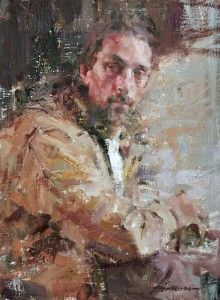
Carolyn Anderson | Dave, oil, xvi ten 12.
Building on her art studies at the university, Anderson has developed her own singular style, learning from other artists who inspired and supported her but fearlessly experimenting with the boundaries of traditional techniques. She credits the late western painter William Reese, whom she calls "an artist'due south artist," with having opened her eyes to new ways of looking at what art can be. Information technology was Reese who said, "I believe our memories take a much better idea about what fine art is than our eyes do, plus our memories practice non recall unnecessary detail." Anderson took those words to center in shaping her philosophy nigh life and art.
Sometimes working from life and sometimes from reference material, Anderson is adamant that a painting exist an interpretation, not a re-create, of her subject affair. She ofttimes begins by employing a dry-brush technique, creating a characteristic scratchy look that avoids the polish appearance of washes or blended paint. Forms are blocked in merely retain a gestural quality. Residue between negative and positive space is critical, and the work must have a sense of integrity, reading well.
A adept example is establish in her painting THE Scarlet Skirt. While not as loosely rendered as many of her artworks, the edges are still near nonexistent in non-focal areas, giving the painting an ethereal quality. Anderson uses edges creatively; their amorphous borders are areas where ane physical object transitions into some other. Every bit with all of her figurative work, this piece is extremely painterly—she rarely blends a single brush stroke, instead depending on countless touches of pigment closely related in color and value. Note how negative spaces (those surrounding the figure), as well as light and shadow, echo and balance i some other and the triangular mass of scarlet brim, however they too add together diverseness and texture to the viewing experience. Even though there is little actual detail, the artist creates a feeling that you know what is there—you bring what you lot know about life to seeing what has been portrayed.
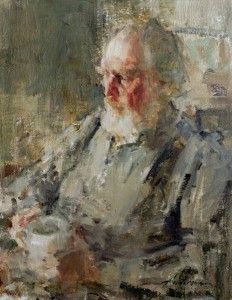
Carolyn Anderson | Begetter's Morning, oil, 14 ten eleven.
An active teacher since the 1980s, Anderson conducts at least half-dozen workshops a year and has taught for the Frye Art Museum in Seattle, Walt Disney Imagineering, the Scottsdale Artists' Schoolhouse, and the Fechin Artists School. While working at Disney, she began to explore concepts of visual language in the extensive fine art library and to use them in her workshops. She finds it rewarding to push her students beyond the technical aspects of painting, to make them question what they see—to enquire, "Is that subject really solid? Is that actually an edge?" She tells them, "Painting is virtually learning to run across. We demand to exist open to the adventure of exploring visual information—to looking at something and clarifying our thinking. Decision-making is a part of that process. The decisions we make are part of who we are as individual artists." Her goal is to open her students' minds to new ways to look at fine art and to help them understand the uses of illusion equally they transform three-dimensional subjects into two-dimensional paintings. It'due south a claiming she never tires of.
Anderson has garnered the admiration of collectors and peers alike. She is a Chief Artist in the American Impressionist Society, and a fellow member of the Northwest Rendezvous (NWR), and she participates in many of the nation's largest shows. Her piece of work has received widespread recognition, including such accolades as the C.M. Russell Artists' Choice award, several NWR Awards of Excellence, two C.M. Russell Best of Show awards, and, most recently, in the 2010 and 2011 almanac American Impressionist Guild national shows, her entries won the Principal Award of Excellence.
William Reese, Anderson'south friend and frequent inspiration, once said, "What is hard and volition take a lifetime to perfect is a painting or sculpture that rings like a bell or sings similar a vocal. To make art that is more like music, we need to kickoff thinking of ways to capture more than of the essence of what nosotros run into." Anderson is well on her way to achieving this lofty goal.
representation
Full Arts Gallery, Taos, NM; Gallery 1261, Denver, CO; Simpson Gallagher Gallery, Cody, WY; InSight Gallery, Fredericksburg, TX; Wilcox Gallery, Jackson, WY; www.carolynanderson.com.
Featured in January 2012.
- Carolyn Anderson | The Red Skirt, oil, xx x 16.
- Carolyn Anderson | Brothers, oil, 12 x ix.
- Carolyn Anderson | Dave, oil, 16 x 12.
- Carolyn Anderson | Father'southward Morning time, oil, xiv x 11.
- Carolyn Anderson | Daughter With Braids, oil, 10 x eight.
- Carolyn Anderson | Kenna, oil, 14 10 11.
- Carolyn Anderson | Little Boy, oil, 10 x 8.
- Carolyn Anderson | Mother'southward Kiss, oil, sixteen x 12.
- Carolyn Anderson | Nude, oil, 9 10 12.
- Carolyn Anderson | Portrait of a Dancer, oil, 14 x 11.
- Carolyn Anderson | Rocky Boy Celebration, oil, 12 x 9.
- Carolyn Anderson | Rocky Boy Dancers, oil, fourteen x 11.
Source: https://www.southwestart.com/featured/anderson-c-jan2012
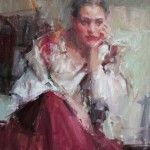
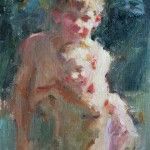
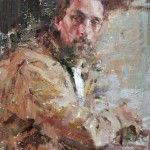
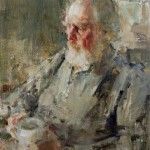
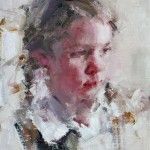
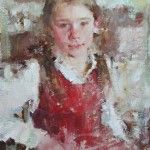


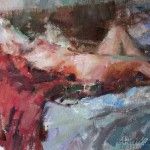
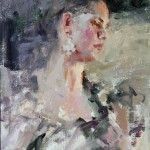
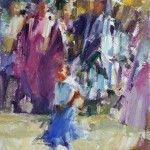
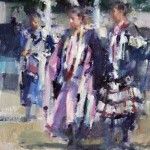
0 Response to "Which Galleries Carry the Art Work of Carolyn Anderson?"
Post a Comment